If I’d paid closer attention to the detailed itinerary Road Scholar emailed prior to our trip, I might not have booked the nighttime feeding tour at Bonorong Wildlife Sanctuary. We’d had a visit to Taronga Zoo, I’d been to Caversham Wildlife Park on my trip to the Pinnacles, Raptor Domain and Kangaroo Island Wildlife Park, and so on. Thus, it’s reasonable to wonder why I’d want to visit another wildlife sanctuary. Although there are a half-dozen or so mammals endemic to Tasmania, I think the answer is best summarized in these two words: Tasmanian Devil. And I don’t mean this guy,

I mean this one.
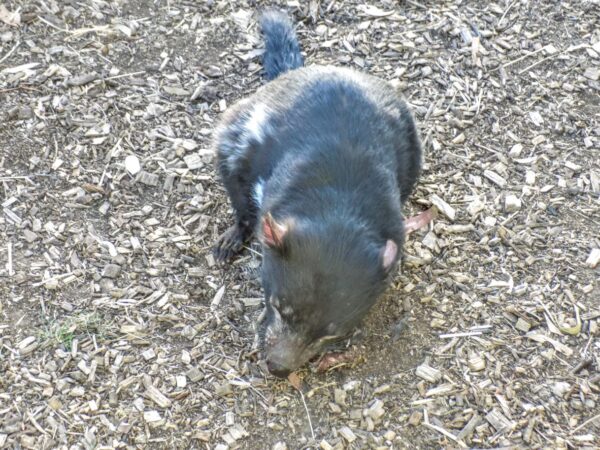
Of course, as a sanctuary, Bonorong (and I hope the reader appreciates the effor I’m putting in to repress the urge to relentlessly fill these pages with puns featuring Sonny and Cher or anything to do with being wrong) has many more animals to see and interact with than just the Sarcophilus harrisii seen in the photo above. I’ll have more to write about this species but first, I’ll provide a closer look at Bonorong and some of the animals I experienced there.
Before the night tour
(Ooh, ooh he’s a smart galah)
As I write this, the home page of Bonorong Wildlife Sanctuary lists four daily tours beginning at 10:00 and ending at 15:30. You need to take the extra step of opening the Experiences section to find the night tour that begins at 17:00 in winter at 18:00 in summer and it is considerably more expensive. (A single entry ticked that includes a half-hour tour currently costs $34.50. The nighttime tour is $174.50 and a little more if you request transportation as I did.) The night tour, however, is {at least} two-an-a-half hours long, has a limited number of people and gives everyone the chance to interact with much of the wildlife such as this youthful wombat (and it’s important that he’s young)
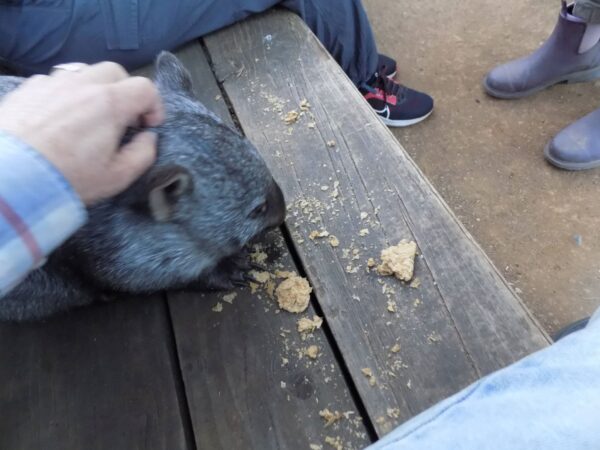
so it’s well worth the difference and all the money – whether day or night – helps support the sanctuary’s work.
Although I arrived about half-an-hour before the tour’s scheduled start, I was the last of our three person group. The others, a couple from North Carolina had gone down to visit and feed the mob of Forester Kangaroos which are a variant of the Eastern Grey Kangaroo and are the largest marsupial endemic to Tasmania.
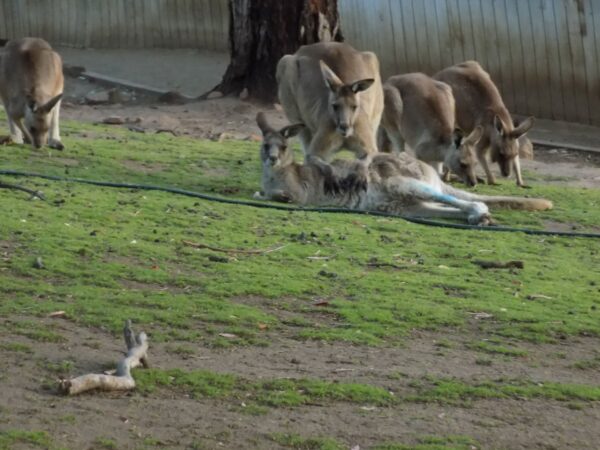
I’d fed kangaroos more than once on the RS portion of the trip so I simply wandered about the sanctuary until I met Robyn who’d be our guide for the evening.
This might sound a bit odd but the highlight of this wander was my encounter with this galah.
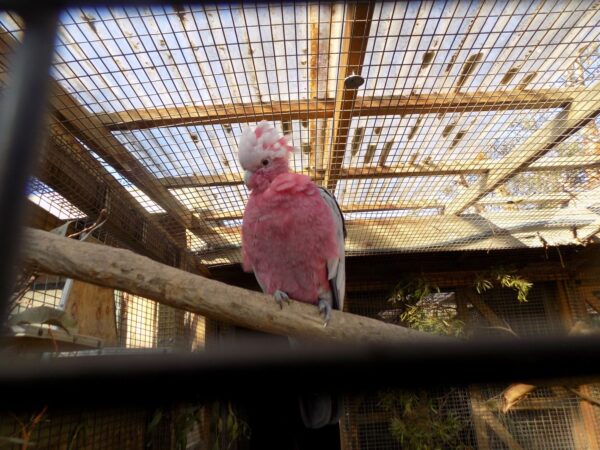
Galahs are a species of cockatoo native to Australia and are very common. We often heard the expression, “You silly galah” in our travels. On the website The Unfurling Aritist, you can find this definition and history of the expression,
Apparently, it’s an “Old Australian” word: a derogatory term that means a ‘loud-mouthed idiot’, specifically appointed to the galah because it makes a distinctive, noisy call.
“You silly galah!” is now usually used affectionately when somebody does something daft. It is also a saying used for gaudy dress apparently because of the bird’s distinctive bright pink. To make a proper galah on oneself is to make a complete fool of oneself. I’m not sure why Galahs have been considered more foolish than other cockatoos.
Another source opines that, “Galahs are known for their playful and sometimes clumsy behavior, which led to a perception of them as not particularly intelligent birds.” I note this because this particular galah must be smart enough to humans might often be bringing food. He left his perch and step by step descended south and east across the fencing of his enclosure until we stood eye to eye.
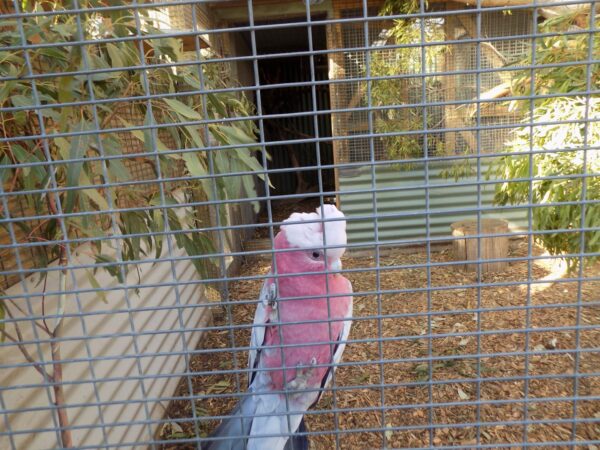
Unfortunately, I had no treats for him. (If you’ve enjoyed the Dreaming stories I’ve shared, you can read the Dreaming story from the Ularai People of how the galah came to have its white head here.
I wandered back to the gathering place where I met the other two people on the tour and Robyn. I don’t often use a person’s full name unless they’ve given me permission to do so and Robyn is a case in point. our RS group had been fortunate to have some enthusiastic and informative guides but Robyn outdid them all and her passion for her work was not merely evident but infectious. She seemed to have a personal relationship with every animal.
Breakfast for some and dinner for others
We started with some easy ones, feeding nuts to some birds (probably what the galah was awaiting) and meeting an Eastern skink (blue tongue and all)

We move on to an echidna – one of Australia’s two monotremes. We’ve seen echidnas before but this is the first time I was able to feed one
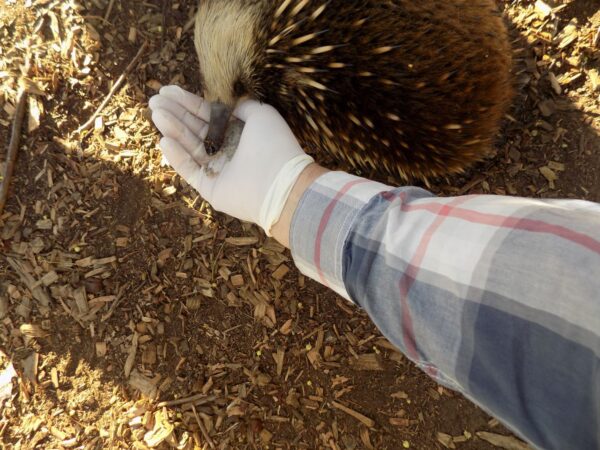
One of the goals of Bonorong, which has a 24/7 rescue service, is to return animals to the wild whenever possible. The case of this little echidna is one of those impossible situations because he’s blind and wouldn’t survive very long outside the sanctuary.
We proceeded from this sweet echidna to a spotted tail quoll. These are native to the east coast of Australia and are the closest living relative of the Tasmanian Devil. However, they are reputed to be considerably fiercer. We dropped little pieces of meat through the wire cage as the quoll ran back and forth munching on its breakfast. (Quolls are mainly nocturnal.) The eastern quoll is endemic to Tasmania.
A Devil of a time
Of the half-dozen or so mammals that are endemic to Tasmania there’s probably none that’s as emblematic as the Tasmanian devil. As you can see from the photo above, devils aren’t very big. Including their tails they’re between 75-100 centimeters long, 25-30 centimeters tall at the shoulder, and weigh about eight kilograms. So how did this relatively small creature come by its evocative name?
It’s likely that three factors contributed to it. While they’re not inherently malevolent, they are very aggressive when feeding (which is why we fed them with tongs that were more than a meter long) and mating. Second, when they their ears turn a particularly bright red. But the main reason the British settlers conferred this name on them was hearing these noises coming from the bush.
We had a few other encounters and learned about the research program to find a vaccine for Devil Facial Tumor Disease – an infectious cancer that spreads through direct contact between the animals, primarily by biting during social interactions like fighting or mating. The disease is fatal and has reduced Tasmanian devil populations by as much as 80% since its emergence.
I want to talk briefly about our encounter with the Wheatabix eating wombat in the photo. Bonorong provides lifetime care for rescued animals that, for any one of a number of reasons can’t be returned to the wild. One of those reason is human habituation. For example, this albino red-tailed black cockatoo
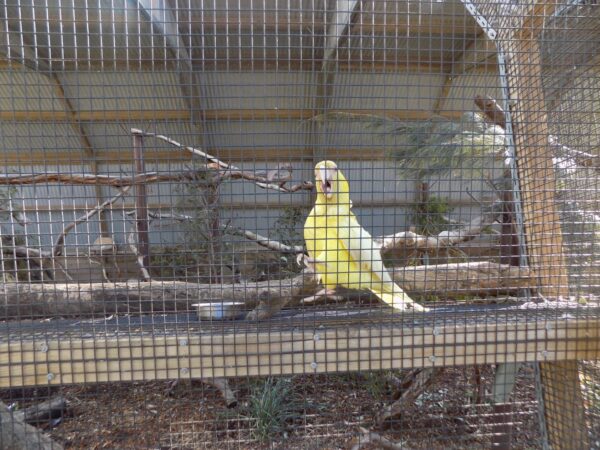
wouldn’t survive because of its albinism but also because it has imprinted on humans as other bird species do. This is not the usually the case with wombats.
Wombats are, by nature, solitary creatures. According to Robyn, wombats will typically begin show independence behaviors around two years of age. Once they begin to display these behaviors such as territorial marking and digging their own burrows, they lose almost all their parental imprinting be that parent wombat or human. In other words, like any adolescent, they want their independence. Bonorong’s staff with then engage in what’s known as a soft release – such as making certain the wombat in is a burrow during the day, finding a safe and secure area, and gently familiarizing the animal with its new home. Once released, the wombats are usually happy to be living on their own.
Here are the visit’s remaining pictures. Tomorrow, I’ll go on a tour of one of the 300 islands that make up the Australian state of Tasmania.